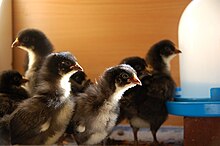Dwarf Lower Rhine
The dwarf Lower Rhine is a breed of domestic chicken .
It was bred as a dwarf blue-pearl and was kept under this name until 1961. The regional reference of the breed name "Niederrheiner" is only applicable for the large breed , as it was bred in Mönchengladbach on the Lower Rhine. The first dwarf animals, however, came from Ehlershausen near Hanover.
history
Ernst Runne from Ehlershausen near Hanover began breeding the "dwarf blue-boar" around 1942, shortly after the creation of the large breed, but had to stop his efforts quickly because there was no place for this new breed in National Socialist Germany and was recognized by had been excluded from the outset. After a fresh start after 1945, it was not until 1953/1954 that Runne was able to complete the official recognition of the dwarf blue claw. In 1961, the breeding committee of the European Association for Poultry, Pigeon, Bird, Rabbit and Cavia Breeding pushed for a "family name" for blue-pork, Kennsperber, yellow-pork and birch-colored of the large breed. The choice fell on the breed name "Niederrheiner", which was subsequently also used for the dwarfed blue pear, which from then on were listed as the dwarf Lower Rhine "blue pear". Further colors were added in 1969 ("blue"), 1971 ("birch-colored"), 1979 ("Kennsperber", "blue-orange breasted" and "blue-birch colored") and 1985 ("yellow claw").
features
Breeding idea: “A medium-high, weather-resistant, happy-growing bantam with a full, rounded body and a medium-sized comb; lively, but trusting. ”In the pedigree poultry standard of the Federation of German Racial Poultry Breeders (BDRG), the dwarf Lower Rhine is described as a" mobile, trusting bantam ".
Hens need four to five months, roosters five months to lay / sexually mature . The laying performance is noted in the standard at 180 eggs per year with a weight of approx. 40 grams, but the specialist literature can also read 200 eggs with a weight of 45 to 50 grams. In addition, the chicken is said to have good fattening properties and fine table meat.
Colors
- Birch colored: Recognized since 1971, bred by H. Schrage and E. Ready, most widespread
- Blue: Recognized since 1969, bred by Gerd Roth (Bischofsheim near Mainz)
- Blue birch colored: Recognized since 1979, bred by Konrad Seibel
- Blue-orange breasted: Recognized since 1979, bred by Gerd Roth (Bischofsheim near Mainz)
- Blausperber: Recognized since 1954, bred by Ernst Runne (Ehlershausen near Hanover), the oldest color of the dwarf Lower Rhine region (initially recognized under the breed name "Zwerg-Blausperber")
- Yellow-blocked: Recognized since 1985, bred by Konrad Seibel, H. Schrage (Bielefeld) and K. Wagner
- Kennsperber: Recognized since 1979, bred by Konrad Seibel and J. Tüncher
- Orange-breasted: the youngest color
distribution
According to a breeding animal survey by the BDRG for 2016, there were around 1,300 animals in 156 breeds in Germany. The top spot in the row of bantams was taken by the dwarf Wyandotten with a good 27,000 animals. Due to the good performance data of the breed, however, a significantly larger number of animals can be assumed. In addition, in the past those responsible repeatedly complained about a lack of reporting discipline, so that the number of breeding animals is probably higher. In the literature it is therefore stated: "Widespread use, very popular bantam". In the context of the breeding stock survey in 2016, 111 roosters and 413 hens were by far the most breeding animals with the color “birch-colored”. Followed by 54.204 “yellow pear”, 50.200 “blue pear”, 25.78 “orange-breasted”, 17.70 “Kennsperber”, 9.33 “blue birch-colored”, 7.22 “blue” and 6.15 “blue-orange-breasted”.
Individual evidence
- ↑ Roth, Gerd: Niederrheiner and Zwerg-Niederrheiner, Reutlingen 1996, p. 49.
- ↑ Roth, Gerd: Niederrheiner and Zwerg-Niederrheiner, Reutlingen 1996, p. 51.
- ↑ Roth, Gerd: Niederrheiner and Zwerg-Niederrheiner, Reutlingen 1996, p. 33.
- ↑ Roth, Gerd: Niederrheiner and Zwerg-Niederrheiner, Reutlingen 1996, p. 49.
- ↑ Roth, Gerd: Niederrheiner and Zwerg-Niederrheiner, Reutlingen 1996, p. 40f.
- ↑ Roth, Gerd: Niederrheiner and Zwerg-Niederrheiner, Reutlingen 1996, p. 33.
- ↑ Roth, Gerd: Niederrheiner and Zwerg-Niederrheiner, Reutlingen 1996, p. 33.
- ↑ Roth, Gerd: Niederrheiner and Zwerg-Niederrheiner, Reutlingen 1996, p. 33.
- ↑ Schmidt, Horst / Proll, Rudi: Pocket Atlas Chickens and Bantams. 182 races for garden, house, yard and exhibition, Stuttgart 2014, p. 170.
- ↑ Bund Deutscher Rassegeflügelzüchter [Ed.]: Zuchttierbestanderammlung final report 2016, Hasselbachtal 2016.
- ↑ Schmidt, Horst / Proll, Rudi: Pocket Atlas Chickens and Bantams. 182 races for garden, house, yard and exhibition, Stuttgart 2014, p. 170.
- ↑ Bund Deutscher Rassegeflügelzüchter [Ed.]: Zuchttierbestanderammlung final report 2016, Hasselbachtal 2016, p. 16.


